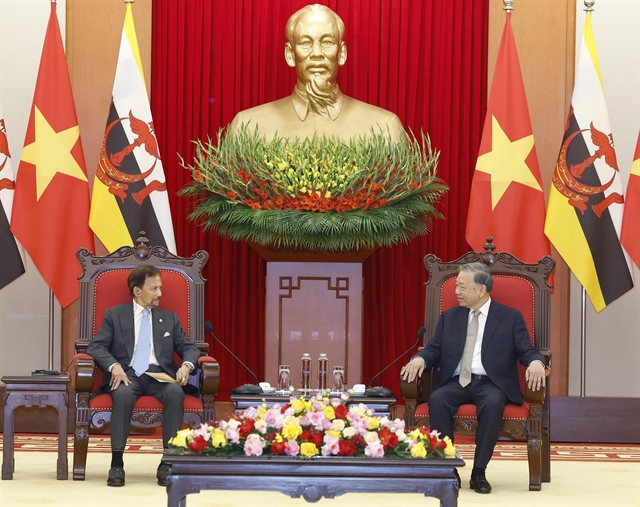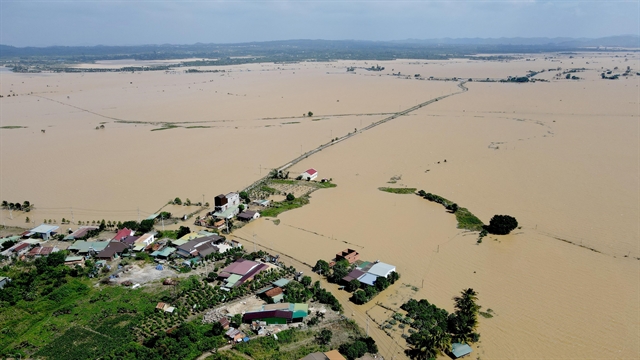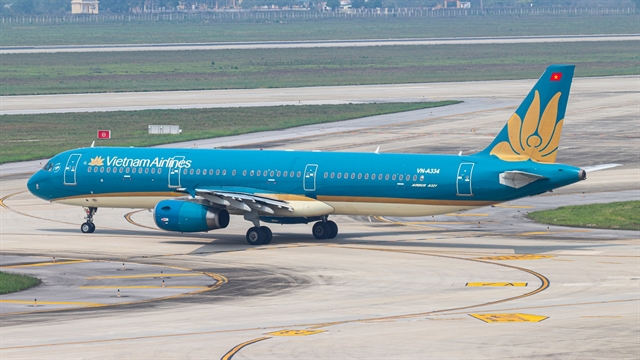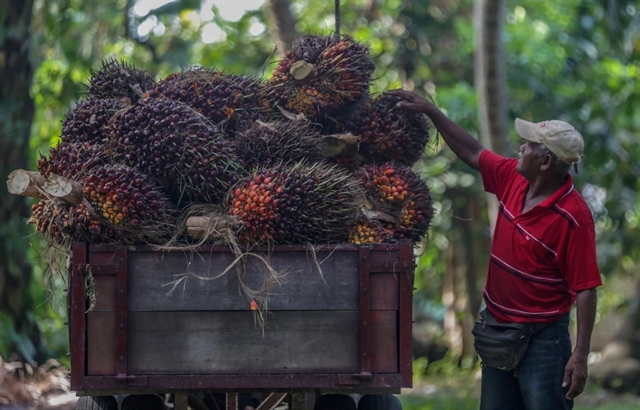 Politics & Law
Politics & Law

Recollecting on what Nguyễn Quốc Uy had gone through during his 10 years in Cambodia as a reporter, especially those years after the Paris Peace Accords, he thought he was lucky to be there in Cambodia in the last decades of the 20th century.
 |
| A group of Vietnam News Agency (VNA) reporters was sent to Phnom Penh in 1980 to help develop Agence Kampuchea Press (AKP), the national press agency of Cambodia (formerly known as Saporamean Kampuchea News Agency). From right: Nguyễn Quốc Uy, Phạm Vũ Tâm, Lê Doãn Tặng, Nguyễn Quang Triệu, Nguyễn Danh Bưởi (standing). — VNA File photo |
By Nguyễn Quốc Uy *
The Paris Peace Accords on Cambodia was signed on October 23, 1991 and just a day later, I received a call from Đỗ Phượng, Vietnam News Agency (VNA) General-Director with an instruction to prepare to head to Phnom Penh.
Before that, I served as VNA resident reporter in Cambodia from 1980 to 1985 and spoke Khmer rather well. I was also no stranger to Prahok, that Khmer fish paste with a smell that has scared away many Vietnamese before me.
I had just 10 days to pack my things and complete paperwork. On November 11, I left Hà Nội for HCM City en route to Phnom Penh. As I arrived, I started to know why the agency selected me for this urgent mission. After the signing of the Peace Accords, we must work quickly to follow the developments. I did not have time to rest. The very next morning, I ran out to call on all the necessary Cambodian offices. I then came to the Vietnamese Embassy in Phnom Penh to see Ambassador Ngô Điền and learn more of the complicated state of affairs in the State of Cambodia of the day. Ngô Điền had been present in Cambodia since the first day when Pol Pot’s genocidal regime was overthrown to help build the young diplomatic service of this country.
Under the Paris Peace Accords, formally titled Agreements on a Comprehensive Political Settlement of the Cambodia Conflict, the United Nations would establish the United Nations Transitional Administration in Cambodia (UNTAC) with more than 21,000 staff both civilian and military from 30 different countries. UNTAC could possibly be the biggest and most expensive peacekeeping operation in the UN history until then.
It must watch all the four fractions on the Cambodian stage, i.e. the Cambodian People’s Party (CPP) which led the State of Cambodia administration, the National United Front for an Independent, Neutral, Peaceful and Cooperative Cambodia or FUNCINPEC under the leadership of Norodom Ranariddh (son of Norodom Sihanouk), the Khmer People’s National Liberation Front or KPNLF under Son Sann and Pol Pot’s Democratic Kampuchea.
Also under the Accords, a Supreme National Council (SNC) presided by Norodom Sihanouk, who stood above all the four fractions, was set up and comprised of 12 members being representatives of those factors.
In the first stage, Sihanouk, as SNC President, and the members representing the political fractions returned to Phnom Penh to function within the framework of SNC under UNTAC’s watch. In the second phase, the 370,000 Cambodians in exile returned and all the Cambodian fractions must disarm 70 per cent of their military forces and move the rest to identified zones under UNTAC scrutiny. Finally, a general election was to be held to form a 120 member-strong parliament with representatives of all political parties. The party that gets a 2/3 majority would form the government. Yet nothing went smoothly as planned. Complex developments, even bloodsheds took place.
As things moved fast, I tried my best to relay all the news and developments back to the headquarters as quickly as I could. At the same time, I accessed different sources to get a clearer picture of the swiftly changing situation.
The CPP had its Central Committee’s plenary during April 22-24, 1992 where Hun Sen, then Second Secretary underlined that ’Before the Paris Peace Accords, the other fractions wanted to win more areas to expand their influence on the diplomatic front. After the Accords, they did their best to mobilise their forces to gain the village bases by increasing propaganda to recruit and exploit our difficulties and internal cracks to stir instability and attack the images of our Party and Government. The Pol Pot group in particular continued to make propaganda and consolidate its organisation to prepare for war and build up its forces, considering it as its strategic mission of vital importance. They continuously violated the ceasefire, firstly in Seam Reap, Kampong Thom and Preah Vihear by moving in forces and ammunition deep into the mainland and attacked some of our localities...’
That was a correct description. The Paris Peace Accords were not executed as it should be. In a news piece in the Tin tức buổi chiều (Afternoon News) of the VNA on May 25, 1992, I wrote: ’The atmosphere in Cambodia seven months after the signing of the Paris Peace Accords is still covered with smoking guns. Until last week, the ceasefire continues to be violated at different scale and degree...’
It became all the more serious at the start of the second phase of the ceasefire on June 13, 1992 as UNTAC could not control the situation. The progress of the Paris Peace Accords faced a deadlock.
In the Accords, there is a provision on monitoring the presence of foreign forces in Cambodia. The fractions opposing the State of Cambodia, particularly the Democratic Kampuchea often claimed about the so-called ’presence of Vietnamese forces in Cambodia’. UNTAC staff had also tried their utmost to search for and finally came up with a document about three people said to be members of the People’s Army of Việt Nam, considering this as evidence of ’foreign forces’ in Cambodia. However, the UNTAC evidence was not persuasive and bluntly rejected by the State of Cambodia’s spokesperson by stating these men had been dismissed from service during 1983-1985 and stayed on to marry Khmer women, received Cambodia ID cards and as such, were Cambodian citizens. In the March 9, 1993 SNC meeting in Phnom Penh, Trần Huy Chương, then Vietnamese Ambassador to the State of Cambodia repeated the Socialist Republic of Việt Nam had withdrawn all of its volunteer forces as well as experts, advisors and military staff out of Cambodia from September 1989 and had not dispatched any new personnel since. UNTAC kept quiet.
The number of Khmer Rouge violations of the ceasefire increased by the day. Taking advantage of the ceasefire during the execution of the Paris Peace Accords, the Khmer Rouge conducted dozens of attacks, killing so many Vietnamese in Cambodia. The most brutal massacre took place in a fishing village in the commune of Cheung Khnar by the Tonle Sap on March 10, 1993. The Vietnamese living there were watching TV when the Khmer Rouge troops opened fire, killing 33 and injuring 24 others. The massacre shocked the world public that was supporting the peace process in Cambodia. On the night of March 31, 1993, the Khmer Rouge again fired B.40 and AK 47 guns on a Vietnamese village’s video lounge, killing 27 and injuring dozens of others. Another massacre also took place at a fishing village by the Tonle Sap just 40km away from Phnom Penh. When we arrived, a Buddhist monk was praying for the ill-fated together with locals. Their coffins were placed on the bullet-ridden boats. We could not hold our emotions when witnessing this and our tears poured out uncontrollably as we recorded the event.
In an article for the Afternoon News in mid-April, 1993, I wrote ’In the past 16 months since the UNAMIC flew the UN flag and formally set up its office in Phnom Penh, the situation is worsening. Hundreds of innocent Cambodians hoping for peace were killed in the Khmer Rouge attacks. The "killing fields" threatens to return as both Cambodians and Vietnamese alike were the targets of Khmer Rouge massacre...The situation has become uncontrollable, tarnishing UNTAC successes in the repatriation of 370,000 people in exile and its registration of 4.7 million voters.’ I then concluded ’Due to the Khmer Rouge’s stubbornness and the UN’s inability to deal with it, the execution of the Paris Peace Accords is like a football game where the ball is just in one side of field, that of the State of Cambodia and UNTAC, as a referee does not allow anyone to cross to the other side of the Khmer Rouge. Under such circumstances, even if UNTAC succeeds in conducting an election in late May and even if the Cambodian People’s Party win, the Khmer Rouge would not face any challenge.’
What came afterwards proved it. Despite the Khmer Rouge’s boycott, UNTAC kept up with its general election plan of May 23-28, 1993 with the participation of 20 political parties. The registered 4.7 million voters went to the booths to elect 120 members of the new parliament. Of course, the election was conducted in the territories occupied by the three fractions, of which the State of Cambodia took up 80 per cent. The Khmer Rouge, far from staying out or missing the train as many international observers predicted, attacked many polling stations and injured many UNTAC staffs and voters.
The social and political atmosphere in Cambodia prior to the election was heavy. UNTAC was trying its best to promote an election described as the most ’democratic’ and ’fair’ in Cambodian history. Yet the people showed their anxiety.
It was during this coverage of the Cambodian election that I came to understand its outcome was vital to the CPP. If the CPP at all lost, the revolutionary forces that Việt Nam assisted to overthrow the Pol Pot genocidal regime would face tremendous difficulties, even went out empty-handed. As such, Việt Nam was very much interested to watch the election.
On May 23, 1993, I drove around the city to have a watch of the election before stopping at the Olympia Stadium polling station. This was where the two most powerful political parties, the FUNCINPEC and CPP were going against each other. Under the strict supervision and protection of the UN security forces, the voting went smoothly and peacefully. I was drawn into the reporting and interviewing of Chea Sim, then CPP President and Norodom Ranariddh, FUNCINPEC President. I was so eager to relay back to the headquarters that full load of information, believing that mine would be the first to be on the pages of Afternoon News. To my dismay, I received a telegraph from Đỗ Phượng instead, saying ’Until now I do not know whether it rains or shines in Phnom Penh?’ I knew his anger. Hà Nội was equally eager to know what was happening in the neighbourhood. I realised my professional mistake: I should have sent my reports first thing in the morning without waiting for the full information collected later in the day.
Then I was lucky thanks to an occurrence during the count. Until the end, everyone, even the CPP leadership, would believe the CPP won. So did I. I was prepared to highlight the swirling victory of the CPP in this election as well. Yet by 10.30am of May 31, 1993, a tip-off came from a reliable source in Phnom Penh informed me that ’CPP and SOC will make an announcement denouncing the polling frauds and rejecting the election results.’ Twenty minutes later, I got hold of the statement with a note ’not to release before 12 noon.’ I understood the Radio Phnom Penh of the State of Cambodia was to air this by that time. So I took all my strength and translated it to relay the full text back to the headquarters even before the Western media got the news. We could finally adjust our communication strategy on the Cambodian election. That afternoon, I received Đỗ Phượng’s commend and a US$100 note for the whole VNA office in Phnom Penh.
Despite all the allegations and evidence of frauds presented by Prime Minister Hun Sen on the television, the election was still considered by UNTAC as a success. The FUNCINPEC got the highest number of the votes but could not secure sufficient seats to form the government and had to align itself with the CPP to form a coalition, hence the two Prime Ministers Hun Sen and Norodom Ranariddh at the same time. UNTAC celebrated the election, noting it did not go empty-handed after spending US$2 billion in this peace-keeping operation in Cambodia. The Khmer Rouge could now laugh at the UNTAC as everything belonging to them (control zones, military forces or ammunition …) remained intact as had been before the Accords. In some places, they even got more land.
Yet the situation remained complex before the formation of the coalition government under UNTAC formula. Due to CPP’s and State of Cambodia’s accusation of fraudulent voting as well as its results, the constitutional process in Cambodia faced a deadlock. On the afternoon of June 3, 1993, Norodom Sihanouk announced his plan for a national reconciliation government presided by him with Hun Sen and Norodom Ranariddh as vice-presidents. We immediately relayed the news back to Hà Nội. But 18 hours later, Sihanouk said he had withdrawn the plan for such a government, watering down our excitement. Again we informed the headquarters of the change. It should be recalled that in February 1993, Sihanouk also had a plan for a provisional national reconciliation government and quickly withdrew it. Some Western reporters described this as Sihanouk’s ’political juggling.’
Amid such a context when a government was pending and UNTAC was yet to find out a solution, another development took place. On June 10, 1993, a demonstration against UNTAC was staged in the provinces of Kampong Cham and Svay Rieng. At the Prek K’dam ferry station, just 30km away from Phnom Penh on the way to Kampong Cham, the staff refused to serve UNTAC vehicles and personnel. On the same day, two members of the CPP Central Committee, Gen. Sing Song and Norodom Chakrapong, announced the establishment of an ’autonomous region’ that included seven provinces to the East and Northeast bordering Việt Nam to boycott the election results.
A day later, on June 11, 1993, Nguyễn Đăng An, another VNA reporter just back from Rome, and I travelled to Pray Veng and Svay Rieng, two of the seven provinces under that ’autonomous region,’ to collect information. At the Neak Loeung ferry station, we saw a number of UNTAC vehicles on the other bank of the river (in Pray Veng province) allowed to travel to this bank (Kondan province) to move to Phnom Penh but not the other way round. It turned out they could only move out of the ’autonomous region’ and not in. From Neak Loeung ferry station to Svay Rieng town, we saw many new check posts and barricades. People had to present their IDs at every check posts but thanks to the SOC cards, we could move with ease. As we met local officials in Svay Rieng, we learned this was just a tactic to put pressure on UNTAC and the opposition parties in the context of an accused fraud election. A week later, the ’autonomous region’ dissolved itself, Gen. Sing Song and Norodom Chakrapong had to go in exile for a number of years until they got the pardon.
The days of writing reports on Cambodia during the time of the UN administration helped me get access directly to the Khmer Rouge in flesh and bone. Before, I could only see them through the photos at the Tung Sleng Prison in Phnom Penh, where their genocidal crimes were on display. The media did not have access to the territories under Khmer Rouge control and could only attend the press briefings at the Khmer Rouge office in Phnom Penh. Once I joined other foreign reporters to cover a briefing, the Khmer Rouge guards insisted that I could not get in as I was holding a VNA press card although I explained to them that the card was issued by UNTAC allowing me to go to all press events by all the parties in Cambodia. Fortunately, many reporters from the West, Japan and even China supported me, so they subdued. However, they refused to hand me the set of documents which was meant to be disseminated to all reporters. Kevin, a colleague from Iceland gave me his and asked for another set. At another briefing, I again saw Kevin wearing a T-shirt with Uncle Hồ’s image and the Vietnamese national flag on. The Khmer Rouge was really angered but could do nothing. I thanked Kevin for his gesture and sentiments for Việt Nam.
The UN thinks it was successful in its peacekeeping operation in Cambodia but the truth could be otherwise. As long as the Khmer Rouge exists, Cambodia can never have peace. Jean Claude Pomonti of Le Monde once compared the Khmer Rouge as a big thorn that Cambodians would have to acquaint themselves with after the election. The Far Eastern Economic Review (FEER) described this state as ’everything is blowing into pieces.’ Nate Thayer and Nayan Chandra wrote on FEER May 19, 1993 issue that ’a year after the US$2 billion election, Cambodia stands on the verge of a civil war. The dry season offensive of the government army ends with terrible confusion and the Khmer Rouge now controls more territories than before.’
Fortunately, the Cambodian people could have what they deserve, peace. The Khmer Rouge disintegrated as its leadership went into a power struggle that ended with the death of Pol Pot in 1998. Others were captured and tried to restore justice for the crime they committed against mankind.
Recollecting on what I had gone through during my 10 years in Cambodia as a reporter, especially those years after the Paris Peace Accords, I am still unable to know how I could do all those things. I do not know from where I got the strength to work day and night through all those briefings and reporting. Anyhow, the one thing I know is that I was lucky to be there in Cambodia in the last decades of the 20th century.
*Nguyễn Quốc Uy was the Director General of Vietnam News Agency from 2006 to 2008. He worked in Cambodia from 1980-1985 and 1991 to 1995
Timeline
November 9, 1991 | First batch of Blue Beret troops from the UN advance team under UNAMIC arrived in Phnom Penh |
November 13, 1991 | Việt Nam Ambassador Ngô Điền arrived in HCM City, ending his tour of duty in Cambodia just a day before the return of Norodom Sihanouk to Cambodia |
November 14, 1991 | Norodom Sihanouk and his wife Monique returned to Cambodia after 13 years of exile in Beijing |
November 16, 1991 | Public march to welcome Norodom Sihanouk’s return. Norodom Sihanouk’s press conference in the afternoon. |
November 17, 1991 | CPP and the State of Cambodia issue a statement recognising Norodom Sihanouk as the constitutional and legitimate Head of State of Cambodia. |
November 27, 1991 | Khieu Samphan, figure head of the Khmer Rouge and its Defence Minister Son Sen arrived in Phnom Penh to prepare for the activities under the SNC. Big protests on the streets from the airport to downtown. Thousands blockading their hotel demanding for revenge. Prime Minister Hun Sen intervened in person to prevent. Armored SOC vehicles sent to protect. |
November 29, 1991 | Vietnamese Ambassador Trần Huy Chương presented his Letter of Credence to Norodom Sihanouk. |
November 15-December 19, 1991 | 12 foreign ambassadors presented their credentials. |
December 19, 1991 | Opening of UNAMIC Office in Phnom Penh |
December 21, 1991 | Students of the Medical College and other universities protested and created armed clashes on the streets of Phnom Penh |
February 26, 1992 | Khmer Rouge shot down a UNAMIC helicopter. This is the first such incident. |
March 11, 1992 | UNTAC formally starts its operation in Cambodia |
March 15, 1992 | Yasushi Akashi formally takes his post as UNTAC Chief of Mission |
March 30, 1992 | Start of repatriation of Cambodians in exile from Thailand |
June 13, 1992 | Start of Phase II of ceasefire. Failure as Khmer Rouge does not allow any UN troops to get in its territory. |




